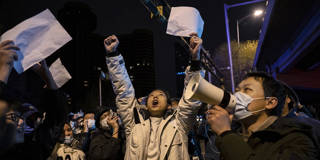Chinese leaders’ refusal to adopt a clear stance on zero-COVID is pure politics: nobody wants to be blamed for whatever surge in infections, hospitalizations, and deaths follows a reopening. But the longer the authorities attempt to avoid responsibility and muddle through, the greater the risk to public health.
CLAREMONT, CALIFORNIA – China has lately experienced its largest and most politically charged protests since the pro-democracy movement in 1989 ended in a massacre by government forces on Tiananmen Square. The recent social eruption should not be surprising; frustrations over the Chinese government’s rigid zero-COVID policy have been brewing for a long time. Yet the ruling Communist Party of China (CPC) apparently did not see the protests coming, despite operating an all-pervasive and deeply intrusive surveillance apparatus. Now, the central government has announced that it will accelerate the shift away from zero-COVID with a broad easing of restrictions. After publishing a set of 20 guidelines for officials to follow last month, it has now cut the list down to ten.
Faced with the protests, President Xi Jinping’s government eschewed brutal Tiananmen-style suppression of the demonstrations. While large numbers of police have been deployed to protest sites, they have avoided bloody “crowd-control” tactics and mass arrests, preferring instead to identify and intimidate protesters using cell-phone tracking technology. But CPC leaders also warned that a “resolute crackdown” was coming. According to Chen Wenqing, the CPC’s newly installed domestic security chief, the authorities will target “infiltration and sabotage activities by hostile forces” and “illegal and criminal acts that disrupt social order.”
While China’s government has sent a relatively clear message about the fate of the protests, its stance on zero-COVID has been hazy and inconsistent, with restrictions being relaxed only in some cities, such as Guangzhou, Hangzhou, and Shanghai. In recent days, the phrase “dynamic zero-COVID” (dongtai qingling) seemed to disappear from state-run media.

CLAREMONT, CALIFORNIA – China has lately experienced its largest and most politically charged protests since the pro-democracy movement in 1989 ended in a massacre by government forces on Tiananmen Square. The recent social eruption should not be surprising; frustrations over the Chinese government’s rigid zero-COVID policy have been brewing for a long time. Yet the ruling Communist Party of China (CPC) apparently did not see the protests coming, despite operating an all-pervasive and deeply intrusive surveillance apparatus. Now, the central government has announced that it will accelerate the shift away from zero-COVID with a broad easing of restrictions. After publishing a set of 20 guidelines for officials to follow last month, it has now cut the list down to ten.
Faced with the protests, President Xi Jinping’s government eschewed brutal Tiananmen-style suppression of the demonstrations. While large numbers of police have been deployed to protest sites, they have avoided bloody “crowd-control” tactics and mass arrests, preferring instead to identify and intimidate protesters using cell-phone tracking technology. But CPC leaders also warned that a “resolute crackdown” was coming. According to Chen Wenqing, the CPC’s newly installed domestic security chief, the authorities will target “infiltration and sabotage activities by hostile forces” and “illegal and criminal acts that disrupt social order.”
While China’s government has sent a relatively clear message about the fate of the protests, its stance on zero-COVID has been hazy and inconsistent, with restrictions being relaxed only in some cities, such as Guangzhou, Hangzhou, and Shanghai. In recent days, the phrase “dynamic zero-COVID” (dongtai qingling) seemed to disappear from state-run media.